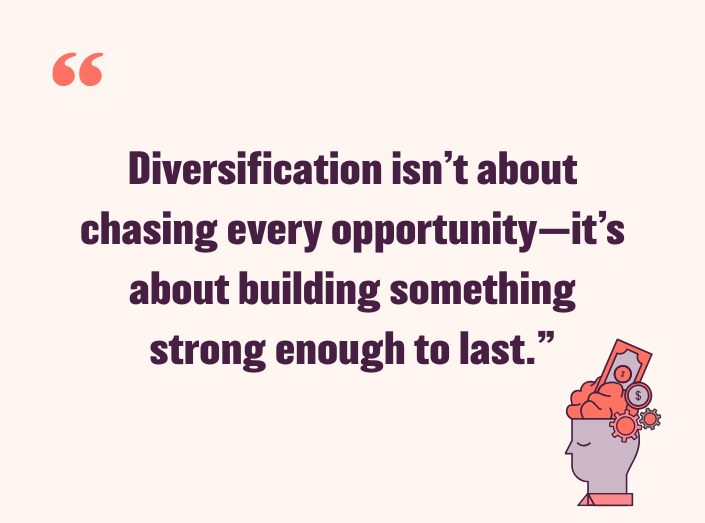Let’s get straight to it, what is a diversified investment portfolio?
If you’ve ever heard the saying "don’t put all your eggs in one basket," then you already understand the basic idea behind diversification. When it comes to investing, that advice is more than just common sense, it’s a proven strategy for managing risk.
So, what is a diversified investment portfolio? In simple terms, it’s a mix of different types of investments, chosen carefully so that if one doesn’t do well, the others help balance things out. It’s not about chasing the highest return. It’s about building something solid that can handle the ups and downs of the market.
This guide will walk you through what diversification actually means, how it works, and why it matters, especially if you’re serious about growing your money over time without losing sleep along the way.

The basics, what does diversification look like?
A diversified portfolio includes a variety of asset types. That might mean combining shares, bonds, cash, property, or other investments. The idea is that these assets don’t all behave the same way at the same time.
For example, when shares go down, bonds might hold steady or even go up. If one sector struggles, like tech, others like healthcare or utilities might perform better. By spreading your investments across different assets, industries, and even countries, you reduce the risk of one poor performer dragging down your whole portfolio.
In short, diversification helps protect your money from unexpected shocks.
Why does diversification matter so much?
No one can predict what the markets will do next. That includes professional investors. Even the most promising investment can go through a rough patch. A diversified portfolio helps cushion the impact of those moments.
When your investments are spread out, you’re less exposed to sudden losses. You also give yourself more consistent opportunities for growth. Diversification isn’t about avoiding risk completely, it’s about controlling it and making it more manageable.
And here’s the key: over the long term, a well-diversified portfolio can offer better risk-adjusted returns than a portfolio focused too heavily in one place.

How do you build a diversified portfolio?
It starts with choosing a mix of different asset classes. That might include global shares, government or corporate bonds, real estate investment funds, and some cash or short-term savings products.
The exact mix will depend on your goals, your timeline, and how comfortable you are with risk. A younger investor saving for retirement might focus more on growth, with a larger share in equities. Someone closer to retirement might favour income and stability, with a greater portion in bonds or lower-risk funds.
Within each asset class, you can diversify further. Instead of buying shares in one company, you might invest in a fund that holds hundreds. Instead of putting everything in one region, you might spread across the UK, Europe, the US, and emerging markets.
You don’t need to pick all of this yourself. Many platforms offer ready-made diversified portfolios matched to your risk level.
What happens if you don’t diversify?
If all your money is in one investment, or even one type of investment, your whole portfolio rises and falls with it. That can be stressful and, in some cases, financially damaging.
For example, if you invested everything in a single company and it had a bad year, your returns could take a hit. Even investing in just one country or industry can leave you overexposed to things like economic changes or political events.
By spreading your investments, you reduce your reliance on any one outcome. You give your portfolio more ways to succeed.

Does diversification guarantee profits?
No investment strategy can guarantee results, and diversification is no exception. What it does offer is protection against the full force of market swings. It’s a tool to help smooth out the bumps and give your portfolio a stronger foundation over time.
Think of it as wearing a seatbelt. It won’t stop every wobble, but it reduces the risk of serious harm when things don’t go to plan.
Managing your diversified portfolio over time
Once your portfolio is in place, the key is to review it regularly. Over time, certain investments may grow faster than others, changing the balance of your portfolio. Rebalancing once or twice a year helps keep things aligned with your original plan.
Life changes too. As your goals shift, whether you’re starting a family, changing jobs, or preparing for retirement, you may want to adjust your mix.
Diversification is not something you do once and forget. It’s an approach to investing that evolves with you.

Final thoughts: smart investing is balanced investing
A diversified investment portfolio is not about playing it safe or missing out. It’s about building a plan that works in good times and bad. It helps you stay invested through uncertainty and grow your money steadily over time.
If you're serious about making investing part of your long-term financial plan, diversification is one of the most valuable tools you have. It’s practical, proven, and surprisingly simple to put in place.
Start building your diversified portfolio with confidence
Download our free app and take the stress out of investing.
You’ll get expert-built diversified portfolios, personalised guidance based on your goals, and tools to help you stay on track, without the jargon.
👉 Download the app now and start investing smarter, not harder
Because investing isn’t about luck. It’s about balance, and the right support to build it.